A Crash Course on Storing, Cleaning, and Laundering Your Cloth Diapers
This post may contain affiliate links. View my disclosures page for more information.
One of the main reasons people choose not to cloth diaper today is they’re afraid of the laundry. I’ll admit, I was there too. The idea of going out, needing to change my daughter, and then bringing home poo was disgusting to me! But, she had constant blowouts (I tried probably 12 different brands and kinds of diapers AND modifying my diet by the time she was 6 mos old), so I finally switched to cloth. They’re not 100%, but their track record is MUCH better than disposables. (If you’re new to cloth diapering, I encourage you to start with Cloth Diaper 101.)
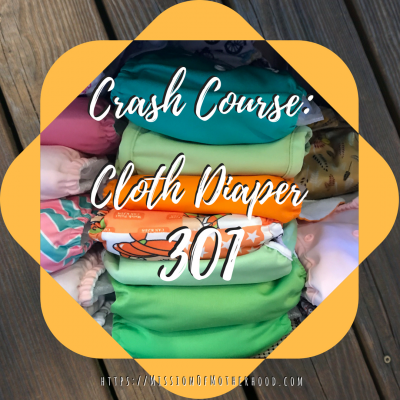
REMEMBER: Cloth diapering has been around for ages. The modern parent switched to disposables for convenience, not because diapers were not getting clean using conventional laundry techniques. With enough detergent and education, cloth diapers are a safe, clean, easy, more eco-friendly, more cost-effective way to diaper your child!
See also:
Cloth Diaper 101: getting started with cloth diapers
Cloth Diaper 201: overnight cloth diapers
Cloth Diaper 301: storing, cleaning, and laundering your cloth diapers
Cloth Diaper 401: cloth wipes, and diaper safe creams, powders, and combatting diaper rash
Cloth Diaper 501: troubleshooting cloth diapers: strip, yeast, and bleach soaks
Cloth Diaper 601: repairs and modifications to your cloth diapers
Prepping Your Diapers Before First Use
Whether new or preloved, the recommendation across the board is to wash all diapers, liners, and inserts before first use. Synthetic fibers and covers only need one wash to be “prepped.” Cold soaks, cold washes, do not get the job done. Other than when they are brand new, diapers are dirty: they need hot water and ample detergent to get them clean. However, as I said above, people moved to disposables for convenience, not because they didn’t get clean.
I like this concise recommendation for prepping your cloth diapers for first use from Fluff Love University. I have tried probably ten different wash routines, and their advice is consistent, solid, backed by science and research, and has never left me with any stinks or stains.
Storing Your Dirty Diapers
I recommend a diaper pail, any will do, but I recommend one with a lid. Diapers stink, and lids contain them. Dogs, bugs, and kids like to get into containers: the stinkier, the better. Lids keep (most of) them out! I have two of these diaper dekor pails. We got one from Amazon and found one at a consignment sale. #win.
I got a cute little decal from Etsy that I stuck on the top. It says “Dirty Fluff Only!” with a picture of a cloth diaper on it that says “WASH ME.” Now no one can confuse it for a regular trashcan!
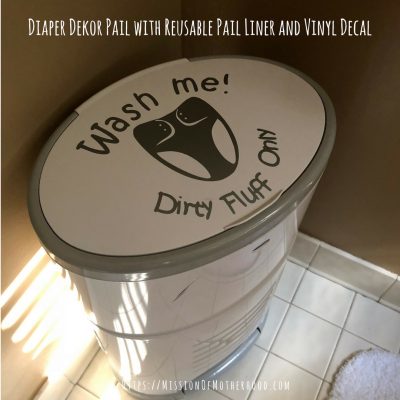
Inside the pail, you’ll need a bag of some sort. I like a cloth pail liner/wet bag, because I can just throw it in the laundry with the diapers. I recommend you get two or three: one to use and one to wash. WAHM, Planet Wise, diaper dekor, Alva Baby, are a few brands that I have, but there are a ton out there. Most come in 2-packs for $20 or less if you search “reusable diaper pail liner” on Amazon.
Store your diapers separated and in a dry pail. It’s a myth that you store diapers in a bucket of Clorox! Take the dirty diaper off, drop it in the pail, put the clean diaper on. Repeat. When the pail is full, it’s time to wash.
Cleaning The Poop
Yep, let’s face it, diapers hold poop, and ya gotta clean the diapers. GROSS. Eh, not really: you’re already cleaning poop off the baby, the diaper is just one extra step. And until baby starts eating solids consistently, infant poop is super easy to clean off. Breastfed baby poop is even water soluble!
I use a couple of options to make the cleanup easier. First, if I can scoop anything with a wipe while I’m wiping the baby’s tushy, I do. Disposable wipes just go in the diaper pail (solids can be flushed but remember you should NOT flush disposable baby wipes in the toilet!). If you’re using cloth wipes (which I talk about further in Cloth Diaper 401), you can dunk and swish in the potty.
Second, clean the poo out of the diaper right away. Resist the urge to drop that ish right in the pail, even if laundry day is soon. Once it starts to dry, it’s harder to get off. I’ve done it many times, but I always wish I’d taken a hot minute right after the change to do it rather than waiting a day.
Third, diaper liners once your kiddo is out of that exclusively-breast-fed-poo stage. I use these disposable liners, but there are a lot out there. Even though they CLAIM to be flushable, I’m on a septic system, so I don’t want to take that risk. They look like a used drier sheet and are not absorbent (so liquid just passes right through it), but they do make cleanup a LOT easier. It’s not 100%, but it’s definitely helpful. The trouble is you kind of need one for every diaper, but when they don’t poop on it, it sort of feels like a waste because you can’t (or at least I don’t recommend it!) reuse them once they’re peed on! It can add up, and while they definitely aren’t necessary, they are definitely a convenience. You can also use a paper towel as a liner, but unlike the bioliners I linked to, paper towels do actually absorb liquid, so sometimes they break apart or cause leaks if they’re sticking out of the diaper at all.
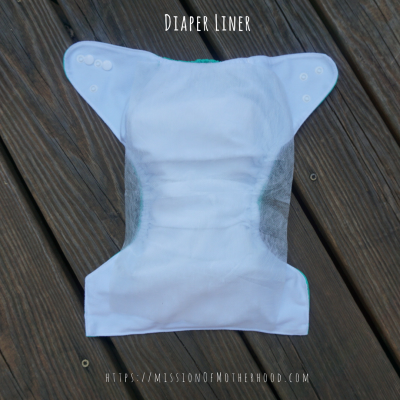
Fourth, if the poo is not solid enough to grab or knock into the toilet, I use gloves, or some kind of grabber, to hold the diaper with one hand and scrape/spray with the other. I heard of these Diaper Dawgs and then actually found some silicone oven mits at Dollar Tree for $1/each. They work exactly the same and are MUCH cheaper. They stay in the bathroom with my diaper cleaning setup, and on laundry day I pop them in the wash with the diapers.
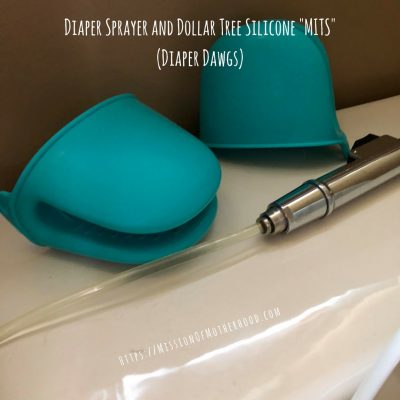
Another thing that makes cleaning poo out of cloth diapers easier when you don’t have a diaper liner or sprayer is something to clean it off with. (Again, I’m talking once your kid is out of the EBF-poo stage since that can just get rinsed right off in the washer). Wipes or toilet paper are ok, but before I had a good poo routine, I used one of these little tiny spatula-looking things for applying diaper cream, or buy a shower brush/rubber spatula from the Dollar Tree. Keep it out of reach and don’t accidentally leave it where someone might mistake it for kitchen or bathing use!
Fifth, I use a diaper sprayer. I cloth diapered for nearly 18 months before I ever got a diaper sprayer, so it CAN BE DONE WITHOUT ONE! However, now that I’ve used one, it’s game-changing. Someone gave me mine, so it was free, but you can search for one like this on Amazon or a cloth diaper BST site. Mine looks indistinguishable from about 8 of the top results on Amazon. They are super easy to install: it took my dear husband a matter of minutes! I never have to touch poo!
I use the mit I mentioned above to take out any inserts (I mostly use pocket diapers), put the inserts in the diaper pail, and then use the sprayer on the pocket where the poo is. If it’s an overnight or fitted diaper, I just disassemble everything into the pail except what needs to be sprayed. I hold the dirty diaper with my mit hand over the toilet (please put the seat up!!!!!!!), and spray the solids down into the toilet. You can buy (or make!) a spray guard like this, but I just practiced my aim with a few clean diapers first (so I wasn’t splashing poo water all over my face/the bathroom) til I got the hang of it. Flush, then drop the VERY WET cover into the diaper pail with a reusable pail liner/wetbag already in place.
To help make the transition from toilet to diaper pail a little less messy, I got a 5-gallon Homer’s bucket from HomeDepot for a few bucks and labeled it “FOR POOP” and it stays in the laundry room (if you make one like the one I linked to, your second trash can serves this purpose). The great thing about the diaper sprayer is I can use it to spray out the bucket if any yuckiness gets in it while I’m doing the transfer.
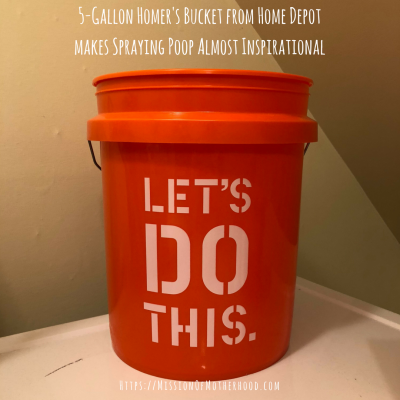
Laundry Time
Now this is the fun part. There is a LOT of information out there about laundering cloth diapers. The first and most important thing to remember is that diapers are DIRTY, so they need a lot of detergent and a lot of water to get CLEAN. None of this 1/4 the manufacturer’s recommended amount of detergent nonsense. No cold water washes. No delicate detergent. Hot washes, extra rinses, enough detergent.
Detergent
I recommend Tide powder: it has more surface area to bind to dirt and minerals so it’s versatile for both hard and soft water. It’s got HE and non-HE varieties. It cleans well, can be bought in bulk, and often has coupons. (Did you know you can double coupons at BJ’s? You’re welcome). Efficient laundry saves everybody time and money. I do not get any commission for recommending Tide to you, but I sure wish I did. It was so effective at cleaning my cloth diapers that we ended up switching to it for all of our laundry, and let me tell you: hot, humid NC summers mean LOTS of sweaty workout clothes, and that smell just doesn’t come out easily. I love my husband but I was about to make him keep even his CLEAN workout clothes in another room! Once we switched to Tide powder, though, all our problems were solved. We have hard well water, but I still cannot recommend this enough.
However, there are a lot of detergents out there that work on clothes and cloth diapers. I recommend you check here for a detergent index on which one you’d like to use is approved. “What about all the chemicals in detergents?” As long as you’re not eating it, detergent is designed to get fabrics clean, and is therefore not going to imbed itself into fabrics. Detergent when used properly is perfectly safe for use on baby clothes and cloth diapers.
While we’re at it, I recommend a water hardness test, both hot and cold taps, in a space as close to your washer as you can get. We use this one, but there are a bunch out there.
Washing Routine
The first thing I always tell everyone, assuming they’re aware of their water hardness, is to find your washing machine here in this index. I can’t stress this enough: the work has already been done for you! FluffLove is an amazing resource with a fantastic track record. They’re the best resource I’ve found and I’ve read a TON about cloth diaper laundry. I used different routines on and off for the first 18 months that I cloth diapered my oldest, and I had stink issues every single time I strayed from FluffLove’s recommendations.
I always make sure the drum of my front-loader LG high-efficiency machine is at least 2/3 full, because 2/3-3/4 full is when it’s most efficient. I took a measuring tape to the inside drum, measured, and marked a line just inside the door at the 2/3 mark.
Per FluffLove’s recommendations for my machine, I put all diapers, covers, inserts, cloth wipes, wet bags, and pail liners until the 2/3 mark is reached, then start my prewash. I use the Speed Wash cycle, hot water (all cold rinses), extra high spin, and Tide powder to line 1.
When that prewash cycle is done, I get in there with my hands and “fluff” the load. That means spinning the drum a time or two, making sure there are no inserts stuck in the door, and everything is peeled off the sides of the drum. If the load is not at the 2/3 mark after that fluffing, I add a towel or some clothes to make the load full enough. For the mainwash, I use the Heavy Duty cycle, hot water (all cold rinses), extra high spin, 1 extra rinse, 1 capful of Calgon, and Tide powder to line 4.
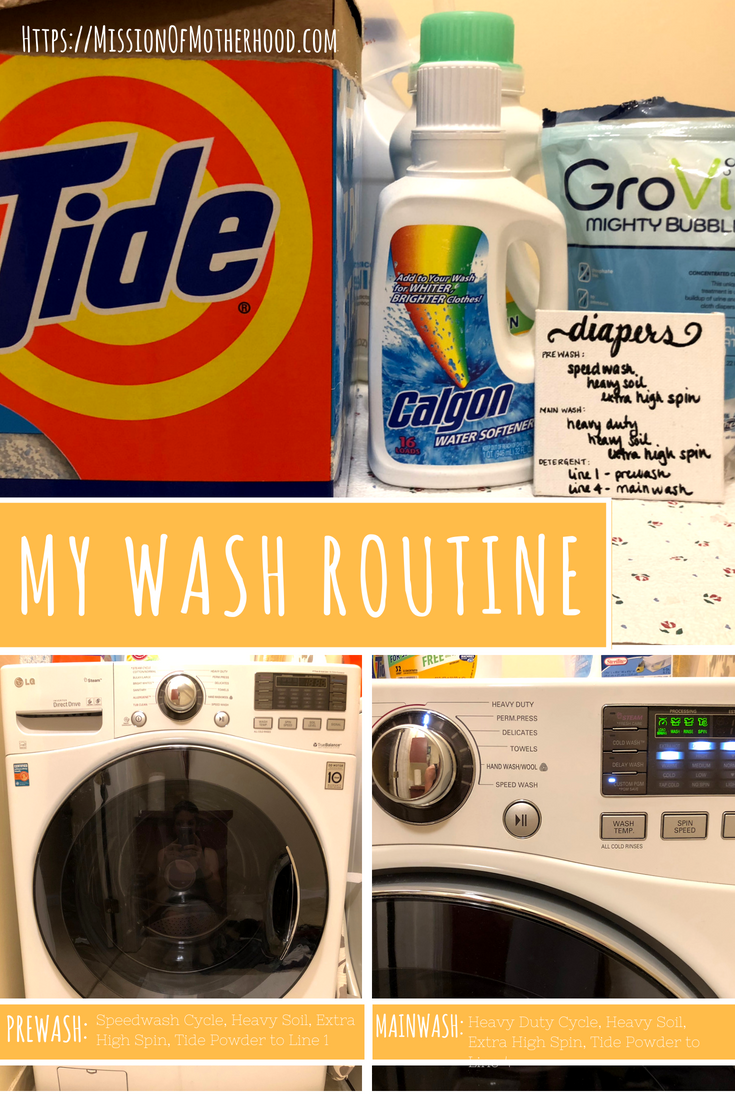
This wash routine won’t necessarily work for everyone since there is a lot of variation in machines out there these days, and water hardness, believe it or not, can be a huge factor. My diapers, however, come out clean, no stains, no stinks, and they’ve held up very well. The other glorious thing is that none of our clothes or towels either in the load, or washed after the diapers, ever have any dirty diaper remnants on them. #praisehands.
Drying Routine
I don’t dry PUL covers or pockets, or anything with elastic in it. The dryer gets too hot, and heat breaks down elastic and PUL over time, which doesn’t help me get the most out of my diapers either in cost or length of life. Some people run their dryer on no heat air fluff but that takes FOREVER! So instead, I bought a drying rack like this one for the covers, fitteds, and pockets (anything with PUL or elastic in it). Added bonus: my laundry room has a window, so they can get some sunlight too. They don’t take long to dry at all, but I don’t leave them outside to dry because it’s just too humid in NC in the summers! Nothing wet dries in this humidity, and anything damp grows mildew. Not a risk I wanna take with my diapers!
I put everything else (again, no elastic or PUL) in the dryer on a normal dry cycle: all my inserts, cloth wipes, FSTs, flats all go in the dryer. NO DRYER SHEETS: they coat the fibers and cause liquids to repel, which affects the absorbency of your diapers! If they come out damp and there’s room on the rack, I’ll add them to the drying rack, if not, I put them in for another normal dry cycle. I use alpaca dryer balls that my mother-in-law made (similar to these) to help fluff all our dryer loads (helps everything get dryer faster, they’re not just for diapers!), but you can also use tennis balls or buy the blue plastic lumpy ones they sell at Bed Bath & Beyond.
That’s a Wrap!
What’s your storage and laundry routine look like? Do you use a different cleaning set up? How does it work for you? What would you expand upon here? Tell me in the comments!

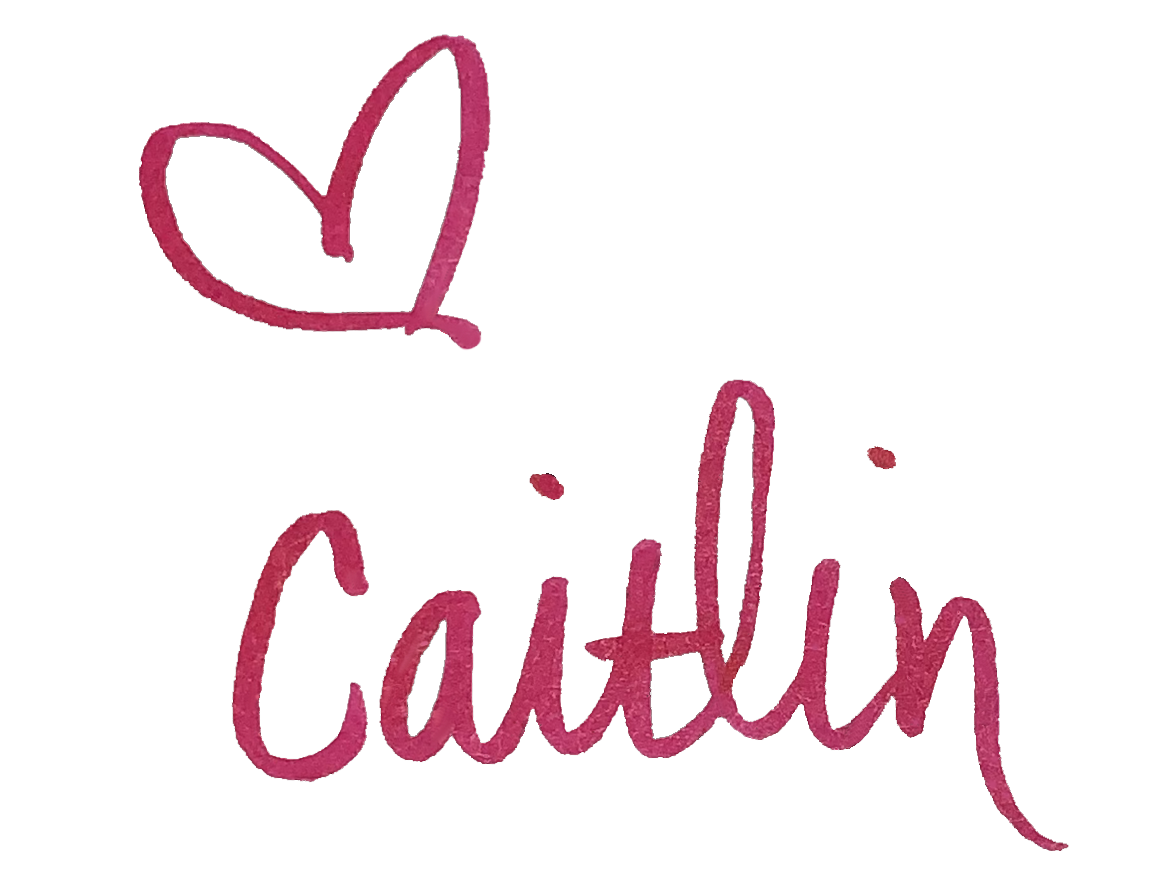
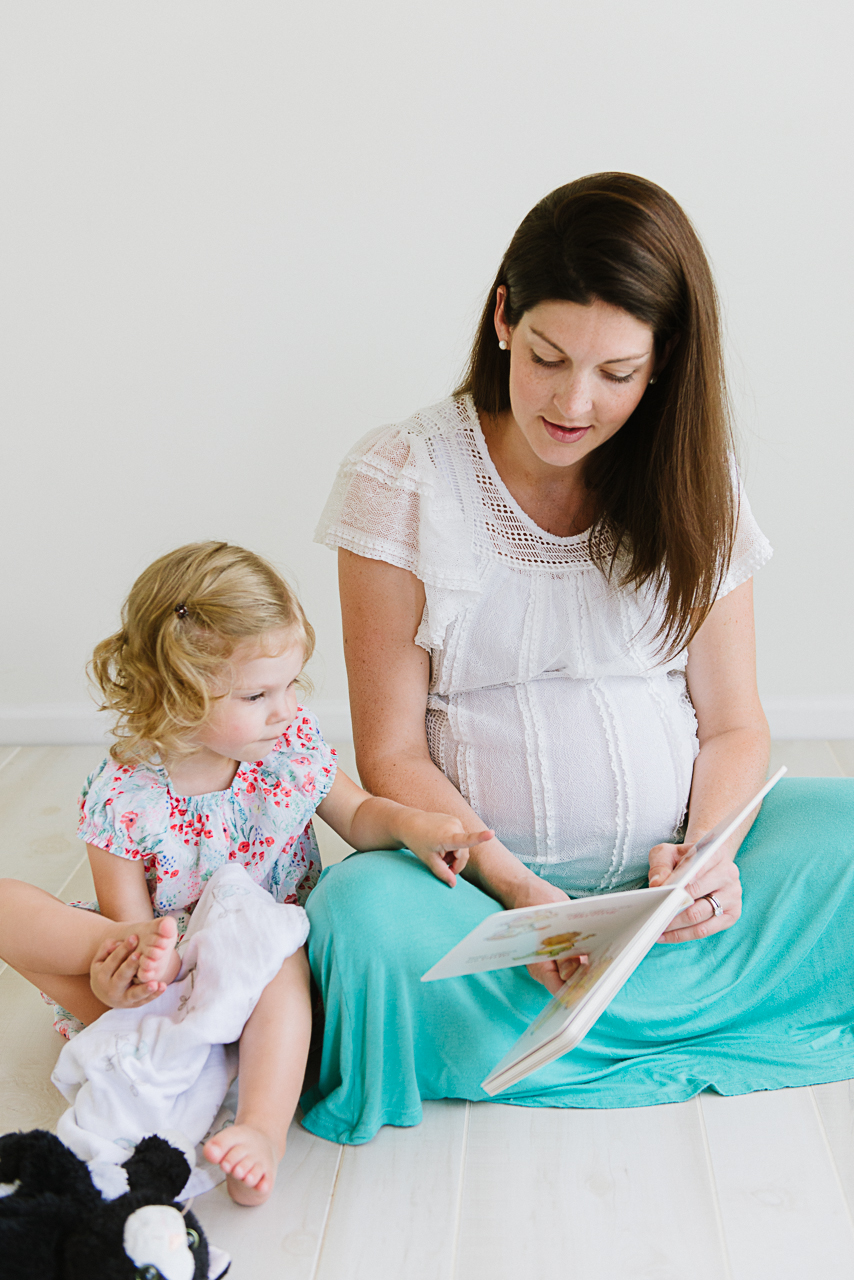
I’ve never tried cloth diapers. I was too afraid of my baby having a blow out in public. I’m intrigued.
That’s what turned me off, too! “If they blow out in public, you have to bring poop home!” My first had blow outs all the time, I probably tried ten different kinds of disposables before I ate some humble pie and turned to cloth. They’re not failproof, but I’d rather have the occasional pee leak than the constant poop leaks I was getting!
Thanks for your great article! I have tried a bunch of things for cloth diapers but I still have a tiny speck(s) of poop each time we finish laundry. Even though I spray the diapers down the toilet. I am beginning to think it could be the water hardness. I also notice it may be where the elastic is where it gets stuck. Any light you can shed on this for me please?
Also, the diapers don’t last longer than 2 hours and almost always leak! I feel guilty for using disposable diapers but this is really getting to me!
Appreciate any advice on this!
Oh goodness, so frustrating! So, if you are still seeing/smelling poop, that means your diapers are still DIRTY. Which either means more water, more detergent, or both. It’s possible water hardness is the problem, you’d have to do a water test to know for sure. I find most of the time moms are simply not using enough detergent to get their diapers clean. When poop got stuck in the elastic grooves for me, I’d use a scrub brush (literally an old soft-bristled hair brush) after spraying to loosen it. I also found most of my cloth diapers did not last as long as 2 hours for my girls, except for some of the nighttime solutions which were simply too bulky for regular daytime use. It’s also possible that your diapers are repelling and not absorbing as well if they aren’t getting as clean in the wash cycle.